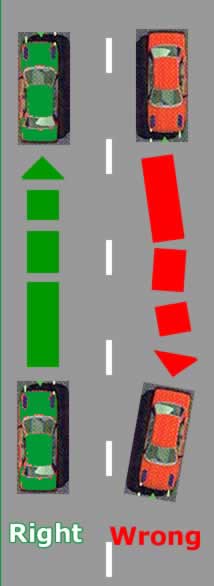Manoeuvres Emergency Stop
Emergency Stop Introduction
Under normal circumstances, a good driver should very rarely have to carry out an emergency stop.
By reading the road well ahead, and anticipating likely problems you can minimise the risk of being caught out.
Always drive at a speed at which you can stop safely in the distance you can see to be clear.
However, emergencies can happen- for instance, when a child runs into the road in front of you- so you must know how to stop quickly and under full control.
This exercise requires that you carry out a controlled stop, as if in an emergency, as quickly as possible under control and without locking the wheels or skidding.
Emergency Stop Instruction
Your examiner will ask you to pull up at the side of the road.
They will explain that they will shortly ask you to carry out an emergency stop on receipt of a given signal and will demonstrate the signal to you.
You will be asked to drive normally and, when given the signal, you should react quickly and bring the vehicle to a prompt stop.

Emergency Stop The Exercise
Your examiner should check that the road is clear behind you before the signal is given. They will do this by checking their mirror and taking a physical check out the back window.
When you receive the signal you should:
- Do not check the mirrors-
you do not have time as it is an emergency.
In any case a good driver will always know what is behind them through regular mirror use.
Keep both hands firmly on the steering wheel in order to stop the vehicle in a straight line.
- React quickly with your feet.
Remember- BRAKE BEFORE CLUTCH (BBC) - do not press the clutch until just before you stop.
This helps with your braking and stability.
Avoid braking so hard that you lock any of the wheels. Remember, even when stopping quickly, follow the rule of progressive braking- pushing the brake pedal harder as the vehicle slows down. A quick reaction is crucial in an emergency. The sooner you start braking, the sooner you should stop!
- Make the vehicle safe
When the vehicle has come to a complete stop, apply the handbrake and select neutral.
When the examiner instructs you to move off remember to check the blind spots over BOTH shoulders.
This is very important as you will already be in a driving position on the road and it is possible for cycles etc to be coming up on your left hand side.
You should stop the car in a short distance, under full control and without risk to other road users.
You should not anticipate the signal by stopping when your examiner is checking the road behind.
You should not skid out of control or allow the car to swing off course.

